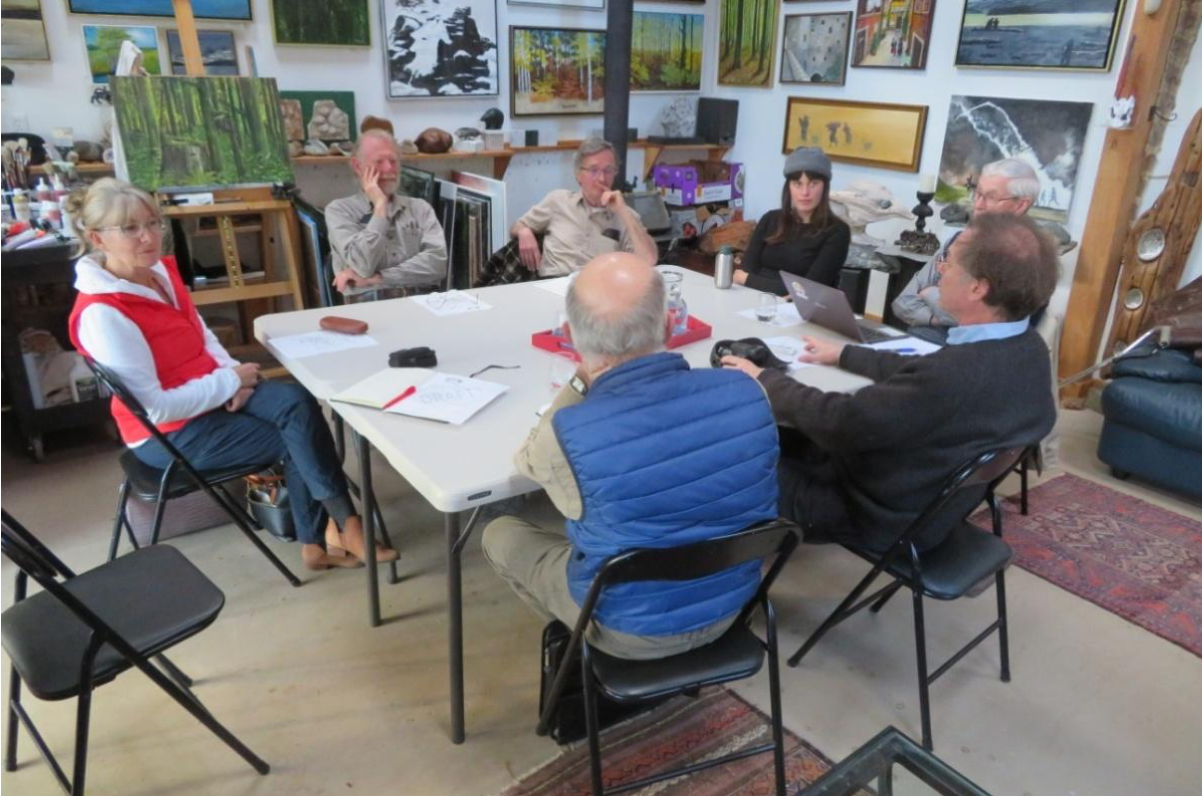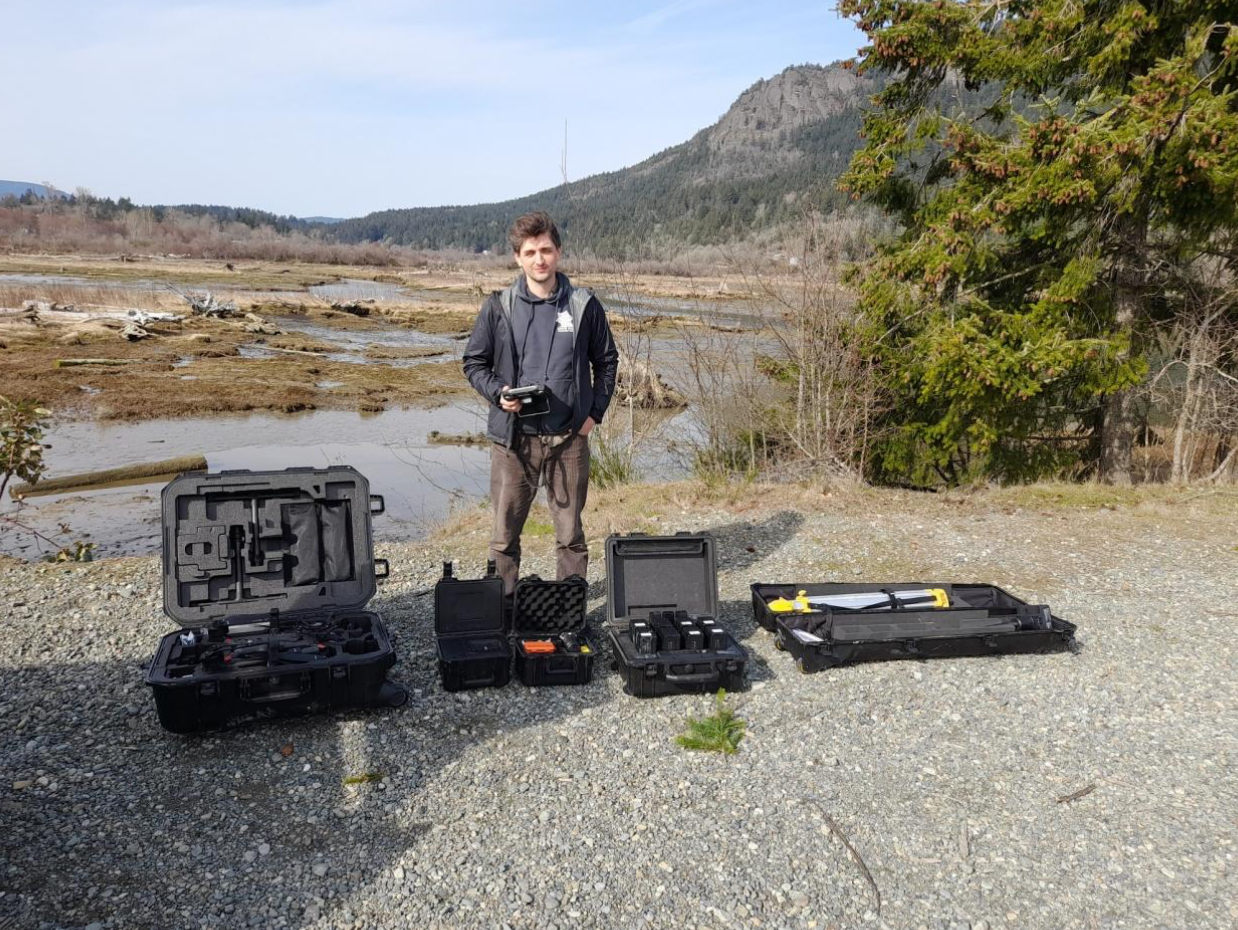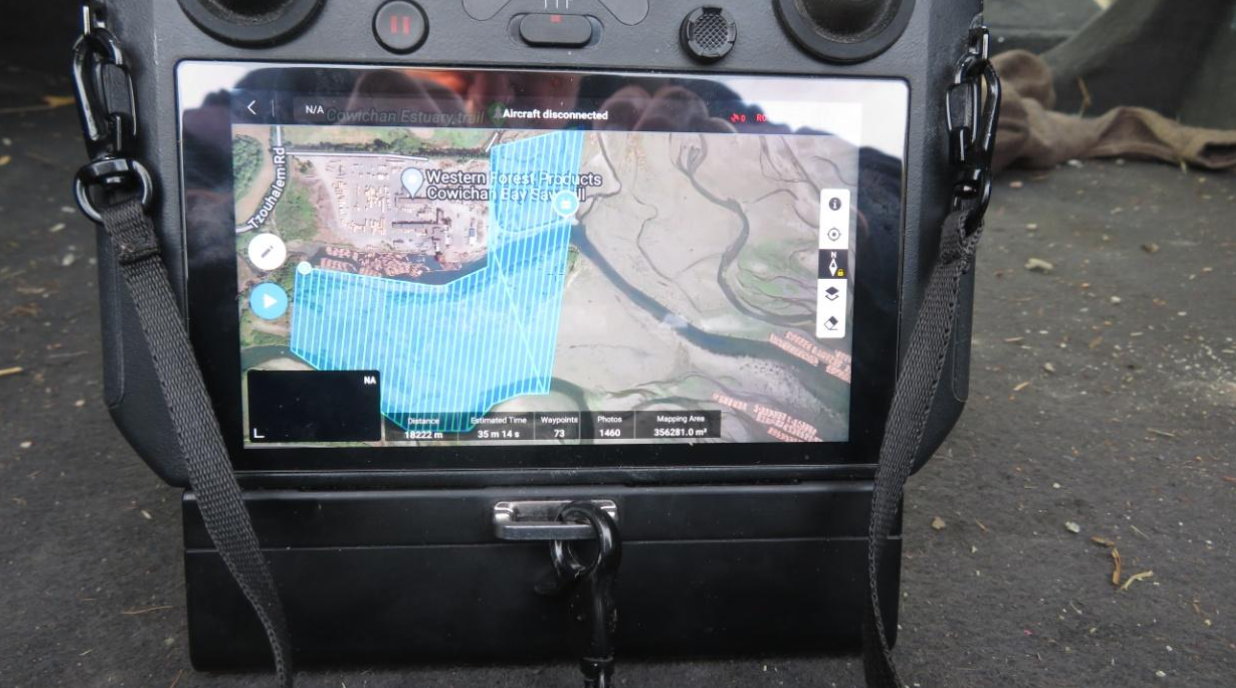Chair Report for January to March 2023
Board meeting March 8, 2023
First I would like to take this opportunity to introduce Julia Bendtsen our new Board member. Julia and her partner Thomas joined CERCA shortly after moving to Cowichan Bay a couple of years ago. Both are keen environmentalists sharing our concern for the estuary. Julia has done a marvelous job last year with the layout and graphical design of the Khenipsen Road Neighbourhood Plan which now forms part of North Cowichans’ new OCP, and the design for the poster for our “Turn off the lights for our insects“ event. Julia has agreed to create a new website for CERCA replacing our outdated site which has crashed a few times already. She also is an accomplished writer which will be a most welcome skill for her work on the Board. Welcome aboard, Julia, I am sure you will be a great asset!
CERCA Board meeting on March 8, 2023. From left to right: Margaret Riess (Treasurer), Bernhard Yuurlink (Director), Cliff Stainsby (Director), Julia Bendtsen (Director and new Board member), Geoff Strong (Secretary), Steve Nazar (invited observer), Bill Heath (Co-Chair — sorry, Bill, for catching only your back). John Atkinson, the eighth Board member, could not make it while being on vacation abroad.
At the Board meeting the proposed activity program for 2023 was discussed as follows:
Micro-Plastics Project Phase II: Ongoing
Citizen Science Project Forage Fish Monitoring: Ongoing
Citizen Science Project Light Trap Dungeness crab larvae monitoring: Ongoing
Citizen Science Project Bat Monitoring: Ongoing
Swallow Population Monitoring: Ongoing
Dock Road nature trail maintenance: Ongoing
MOTUS migratory bird telemetry tracking with Canadian Wildlife Service: Ongoing
Lobbying for:
promoting green corridors Quamichan Lake-estuary, Somenos Marsh-estuary, South-facing slope of Mt. Tzouhalem Ongoing
Lobbying against:
inter-tidal log-boom storage Ongoing
saw logs contaminating Mariners Island Ongoing
light pollution in the estuary Ongoing
rezoning Crown Lease 103103 for conservation management Ongoing
industrial effluent discharge into estuary Ongoing
Micro-Plastics Project Phase II: PostDoc Zeinab Zoveidadianpour started work in November 2022 under the supervision of Dr. Leah Bendell from Simon Fraser University and Dr. Juan Jose Alava Saltos from UBC. The trial sample processing of varnish clams collected from The Comox and Cowichan estuaries in late fall of 2022 has now been completed by Zeinab at Dr. Bendell's Simon Fraser laboratory. Phase II involves cooperation with Project Watershed to compare the Comox- with the Cowichan estuary. It involves sediment samples using the same geo-referenced sites from last year plus additional sites needed for a statistically viable sample size. It also includes an upstream sampling of tributaries of the estuaries to identify sources of contamination. Life samples will focus on varnish clams, forage fish and salmon species to be supplied by BC Conservation Foundation. CERCA and Project Watershed from Comox cooperate with the Canadian Wildlife Service, Simon Fraser University, and UBC.
The CERCA Board agreed on the implementation of a Symposium on our microplastic project before starting the sample collection in May. Major stakeholders including Cowichan Tribes, representatives from the CVRD, North Cowichan, Cowichan Watershed Board, and stakeholders from the Comox estuary will be invited. The rationale of the Symposium is raising awareness of microplastics contamination of estuaries and estuarine food webs.
Following the Symposium we will send out a call for volunteers needed for the fieldwork to assist the researchers in sample collection. The samples will be sent to Vancouver to be processed by Zeinab. As reported earlier the Cowichan Comox Estuary Team (CCET) is now composed of Leah Bendell, Juan Jose Alava Saltos, Zeinab Zoveidadianpour, Caitlin Pierzchalski (Project Watershed), Bill Heath, Goetz Schuerholz, Mark Drever, and Scott Flemming from the Canadian Wildlife Service. In addition to the Postdoc fellowship, Dr. Bendell has secured one graduate student working on other aspects of the microplastics study. Meanwhile, CERCA received $10 K from the Canadian Wildlife Service to cover the required financial contributions by CERCA and Project Watershed to the Mitacs PostDoc fellowship for the first year of the Phase II study.
Citizen Science Project Forage Fish Monitoring: Bill Heath continues to spearhead the MABBRI project on forage fish beach monitoring including the North shore of the Westcan Terminal and a beach at Maple Bay involving students from Cowichan Secondary School.
Citizen Science Project Light Trap Dungeness crab larvae monitoring: Again, Bill will assume overall responsibility for this year's crab larvae monitoring HAKAI project starting in April. The light trap anchored to the dock of the Maritime Museum will be checked three times weekly, twice by Bill and once by myself.
Citizen Science Project Bat Monitoring: After the 2023 most successful bat project with highly positive public feedback, the 2023 bat season will involve a two-pronged approach agreed upon by the CERCA Board. Bernhard Yuurlink, Cliff Stainsby, and Bill Heath will conduct a scientific study on bat distribution, habitat use, and activity pattern using a new recording device called "AudioMoth" which is expected to reduce the bias in species identification as experienced with the Echometers used so far. All three will attend an international bat conference held this spring in Victoria.
The second component of our bat project will continue using Echometers as in the past involving more persons within the Cowichan Valley. We will offer the gadgets to other environmental groups in the Valley. We hope to thus contribute to public education, and raise awareness of bats and their important ecological role, and hopefully reducing the widespread prejudices against and the fear many people have of them. Goetz will be guiding the implementation of this project involving two Echometers for android phones and two for iPhones. To make the data collection more consistent, we will have fixed recording periods for each location. In short: one scientific study using "AudioMoth" and one popular science project using "Echometers".
Cliff Stainsby and Tristan Douglas have done a great job processing the vast volume of last year's data which will be summarized in a final report by Goetz as soon as all ten recording locations from 2023 will be covered by ecological site descriptions to be conducted by Goetz, Cliff, and Bernie to be completed by the end of March.
To address the second objective, the Board of Directors has asked Bernhard Juurlink, along with Bill Heath and Cliff Stainsby, to organize a symposium on bats located in BC, specifically Vancouver Island. This symposium will be aimed at the general public and held on World Environment Day on June 5 , 2023. The anticipated outcome of this symposium will be to have the public better appreciate the important roles that bats play in our environment. The location of the symposium will be the large lecture theatre at Vancouver Island University, Duncan, BC campus. This theatre holds 120 people.
Swallow Population Monitoring: This project is now entering its seventh year. During the 2023 nest box cleaning we noticed that several boxes have disappeared. The missing boxes were most likely attached to old dolphins along the Cowichan River South Fork that finally keeled over possibly being washed away by King tides. Due to the continuing low occupation rate at this site we are still searching for a more suitable location. If we are successful in finding a better site we will move the boxes before the nesting season.
Dock Road nature trail maintenance: We shortly will send out a call for volunteers to jointly with volunteers from Cowichan Valley Naturalists remove invading broom and brush- clean the trail where needed. After walking the trail we decided that brush-cutting by a bobcat with a side-cutter would not be justified but will take place next year again. A two-year interval for brush-cutting appears appropriate.
MOTUS telemetry tracking: The station placed at a Khenipsen Road property needs some repair after weathering the winter storms. Some of the guy wires need replacement to stabilize the antenna. We are now waiting for the spring migration of shorebirds using the estuary as staging area on their flight up North. The recorded data from the chipped birds are entered into the data system maintained by the Canadian Wildlife Service. The metadata are accessible by all participating researchers along the West Coast of the Americas from Alaska to Peru.
Environmental awareness building:
CERCA's educational program now entering its sixth year involves inter alia the environmental class of the Cowichan Secondary School. As in the past, the approximately 40 students from grade 11 and 12 will be taken on an educational walk along our dock road nature trail in May to be lectured on the estuary's ecology, traditional use by First Nations, threats to its integrity, and efforts to restore its ecological integrity. This will be followed by students selected to help Bill Heath with the forage fish monitoring project in May and June 2023. This is the first year that CERCA will not take any interns due to the lack of meaningful hands-on work projects during this year's summer season.
As in past years, Goetz will continue to take out groups from the CVRD Elder College to continue with estuary lectures along our nature trail. The trail walks organized by the CVRD's Elder College have been very popular amongst Cowichan Valley residents.
Goetz also will provide the "traditional" lecture about estuaries to the UVIC class on coastal ecology offered by UVIC's Department of Geography, using the nature trail open-air classroom.
Lobbying for:
GreenCorridors: Goetz actively promoted the establishment and sustainable protection of the three green corridors 'Quamichan Lake-estuary', 'Somenos Marsh- estuary', and the 'South-facing slope of Mt. Tzouhalem' as proposed by CERCA to the Municipality of North Cowichan. The identified ecological corridors constitute critical wildlife habitat associated with the Cowichan estuary. We have lobbied the corridors in writing and meetings with MNC Council, Dr. Preikshot (Head of the Environment Department), and Cowichan Tribes. In a recent meeting with Dave Preikshot the green corridor issue was highlighted as a Key topic for the upcoming biodiversity strategy of North Cowichan. Since the establishment of the corridors covers substantial sections of First Nation Land, North Cowichan will discuss cooperation with Cowichan Tribes.
Lobbying against:
Saw logs on Mariners Island: In one of the previous letters I reported on the drone survey of Mariners Island, which we conducted in early spring 2022 to document the major wash-up of logs during the winter of 2021/2022 along the shoreline and onto the salt marsh of the Island. The resulting photo record was submitted to Western Forest Products (WFP) with the request to immediately remove the logs before causing further damage to the fragile salt marsh vegetation. Subsequently, some of the logs were removed from the shoreline at the outer edges of the salt marsh, the logs from the marshland proper were not retrieved due to the high costs of retrieval by helicopter, the only appropriate method without damaging the salt marsh vegetation. During the winter of 2022/2023, even more logs were washed onto the Island.
In a meeting with the WFP Mill Manager and other Mill personnel on March 13 this issue was discussed at length (myself and Bob Down attending the meeting). The Mill Manager is now waiting for the results of the drone survey of Mariners Island conducted by Tristan Douglas on March 16. Tristan will attempt to use software that may allow automatically counting the logs identified on the drone imagery. Once the imagery is processed and the number of washed-up saw logs are known we then will decide with the Mill personnel how to retrieve the logs which should be completed before spring green- up and the start of the bird breeding season. Tristan also intends to produce a high-
resolution orthophoto of Mariners Island to be used for future monitoring.
Tristan setting up the drone equipment on the spit at the mouth of the mill pond.
Marking the area to be covered by the drone survey. The white lines indicate the flight passes including all of Mariners Island and a salt marsh section east of the mill.
Controlling and following the drone.
Impacts of WFP Mill's Light Pollution on insects and bats: In the summer of 2022 CERCA celebrated its 10th Anniversary, dedicated to insects in a campaign called "Turn off the lights for our insects in the estuary". WFP was highly cooperative turning off Mill yard lights for two nights in a row in tune with the campaign. However, since then there were no dramatic changes noted to the bright lights of the mill continuing to attract insects from surrounding areas.
The bright light issue and its impacts on insects were also discussed at the March 13 meeting. This was followed by a visit from Phil Klaasen, the new mill maintenance supervisor to the North shore of the estuary to identify the exact location of the bright lights on the mill site. The offending lights were successfully identified and Phil promised to solve the problem shortly. He also reported that last year he has seen many bats flying around the mill lights feasting on flying insects. It was agreed to record bat activity one night with the lights on and another with lights turned off in the middle of this year's bat season.
Rezoning Crown Lease 103103: The return of this abandoned Crown Lease for conservation management triggered the creation of CERCA in 2012. This Lease was originally held by MacMillan Bloedel for log boom storage to the south of the Westcan Terminal. The Cowichan Estuary Environmental Management Plan stipulates the return of abandoned Crown Leases in the estuary for conservation management. All CERCA's efforts to achieve this have failed.
In 2017 the seven Crown Leases related to the Westcan Terminal, originally all allocated to the Forestry Industry, were subject to a re-zoning application to accommodate the metal manufacturing industry which illegally had taken place for years on the Terminal. The re-zoning application was strongly promoted by the former Area Director for Area D, claiming that this would be a win-win for everyone. It was promised that Lease 103103 would be re-zoned for conservation if the re-zoning of the remaining six Leases in favor of metal manufacturing would be approved by the CVRD. You may recall our fight against the re-zoning which finally was approved against better knowledge and wisdom without re-zoning Lease 103103 for conservation as promised.
We are still lobbying for this to happen. With the recent Agreement by 200 Nations at the Biodiversity Conference hosted by Canada, we made a new push for the Government to rescind the Lease in favour of wildlife habitat management. As a signatory of this Agreement Canada is obliged to set aside 30% of its land surface area and 30% of marine ecosystems for sustainable protection, with estuaries figuring high on the priority list of marine protected areas.
Banking on the commitment by the Government Goetz has send letters to the Federal Agencies, Provincial Authorities, and Local Governments to assist in returning Lease 103103 to be managed for conservation as a first step towards placing the entire estuary under protection. Ideally, the Cowichan Estuary should form part of the core areas of the proposed Salish Sea Conservation Area, an ambitious undertaking by Parks Canada. We
are still waiting for the response to our letters and request.
WFP effluent discharge permit: Western Forest Products sawmill has applied for a permit for an effluent discharge into the mill pond. The mill which has been operating since 1975 never had such a permit, thus allowing effluents to flow into the estuary without control all these years.
Bernhard Juurlink has spearheaded inquiries with the Ministry in charge of effluent discharge permits and WFP regarding the nature/composition of effluent components, their volume, and times of discharge. The current storm water is collected from the hardcover part of the mill site by several oil separation chambers before flowing via 8 pipe outlets into the mill pond. We are also inquiring about how to deal with the storm water from the extensive graveled section of the mill yard which flows uncontrolled into the ditches to the north of the mill draining into the estuarine salt marshes. The graveled part is used mostly for the storage of milled lumber treated with anti-foulants. CERCA will leave the follow-up to Bernhard Juurlink who will stay on top of the permit application process in detail.
Financial: At the last Board meeting Margaret presented the current financial statement which includes the 10K donations from the Canadian Wildlife Service. Margaret reported that only 34 members have paid their 2023 membership fee so far, fees which are due on January 1 every year. Please follow her instructions on the reminder Margaret has send out yesterday to make your payment. We need the membership fees to prove to the Government that this covers our operational costs of approximately 1.3K annually. We do not want to lose our charitable status over this.
If you do any gardening I wish you all a happy planting season.Maybe you will prefer native plant species instead of introduced horticultural plants which may become invasive. You also should think about creationg biological diverssity in you backyard helping our insects and native
wildlife.
Cheers,
Goetz Schuerholz, Chair




